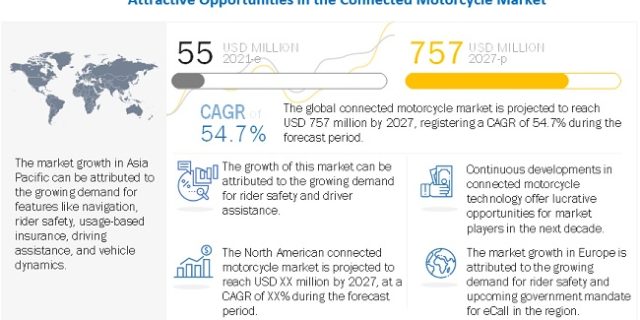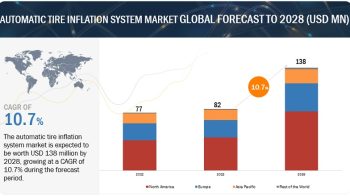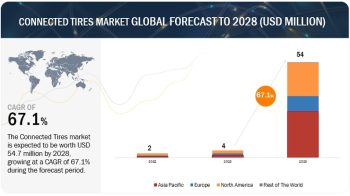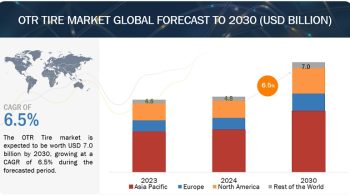
The global connected motorcycle market size is projected to grow from USD 55 Million in 2021 to USD 757 Million by 2027, at a CAGR of 54.7%. Factors such as increasing demand for connected motorcycles around the world, growing demand for motorcycle safety and driver assistance along with growing demand for usage based insurance and infotainment systems in motorcycles will boost the demand for the connected motorcycle market. The upcoming regulations for rider safety in motorcycles in countries around the world will also boost the market. The connected motorcycle market is dominated by major OEMs including Yamaha (Japan), Suzuki (Japan), Kawasaki (Japan), BMW (Germany), and Harley Davidson (US) and component manufacturers include Bosch (Germany) and Continental AG (Germany). Many software providers, including Starcom Systems (UK), KPIT (India), and e-Novia (Italy), work with platform providers like IBM (US) and Amazon AWS (US) and network providers like Vodafone (UK) and Verizon (US) to develop product and service offerings for the connected motorcycle ecosystem. They have initiated partnerships to develop their connected motorcycle technology and provide finished products to their respective customers for the connected motorcycle market.
Safety systems in motorcycles are designed to save the lives of riders. OEMs are incorporating safety features in motorcycles for a safe riding experience. However, safety features work with the help of cameras and sensors fitted on the motorcycles. These features analyze data from in-vehicle sensors. Hence, safety features are not useful in case an approaching vehicle is far or is out of sight or visual is blocked by large vehicles. The connected motorcycle allows communication with other vehicles and thus extends the functionalities of the safety system. Left turn assist helps riders avoid a collision with oncoming traffic when turning across the opposite driving lane. The rider can easily overlook or misjudge the speed of oncoming traffic. In such a scenario, a fatal accident is inevitable. Meanwhile, the motorcycle approach warning/indication informs other road users that an approaching motorcycle is nearby. The vehicle-to-vehicle communication system collects and analyses real-time vehicle speed and position. The overtake warning system warns the rider not to attempt overtaking as the passing zone is occupied by the oncoming vehicles. The system works with the help of vehicle-to-vehicle communication. It can inform a rider to avoid overtaking when there is an oncoming vehicle. The emergency electronic brake light warning takes the forward collision system one step ahead. The forward collision system uses radars and cameras to detect strong deceleration or sudden braking by preceding traffic.
Request Sample Report: https://www.marketsandmarkets.com/requestsampleNew.asp?id=16392581
The Asia Pacific region comprises major motorcycle markets such as China, India, Indonesia, the Philippines, and Vietnam. The region accounted for more than 90% of the global motorcycle sales in 2020. As two-wheelers are a preferred mode of transportation due to affordability and low maintenance, Asian countries such as India, Thailand, Indonesia, and Vietnam have a high motorcycle penetration. Mid and budget-segment motorcycles dominate the market in these countries. However, with a steady increase in disposable income and rising demand for high-performance motorcycles, the region has attracted a number of premium motorcycle manufacturers. The region is home to some of the most innovative motorcycle manufacturers, such as Honda, Kawasaki, Yamaha, and Suzuki. These OEMs are taking active participation in the Connected Motorcycle Consortium to develop connectivity services for motorcycles. They have already launched bestselling motorcycles in the budget segment with connectivity features. For instance, in October 2020, Yamaha launched its special edition FZS-FI motorcycle which comes with the Connect-X connected motorcycle application. Kawasaki also launched its new connected motorcycle, the Z 650 in May 2020. It comes with a 649-cc drivetrain and liquid-cooled 4 stroke twin engines. Similarly, in September 2021, Suzuki launched GTX 1000, which comes with the Bosch developed mySPIN connected vehicle application. The app provides features like route sharing, weather control, and navigation control, among others. The high sales volume of motorcycles would drive the growth of the connected motorcycle market in the Asia Pacific region. With a small percentage of motorcycles becoming connected over the years, the Asia Pacific market would easily surpass other markets due to high sales of two-wheelers in the coming years. Also, international motorcycle manufacturers have entered this regional market and introduced sports and adventure motorcycles with high displacement engines. Increasing millennial preference for high-performance motorcycles and changing lifestyles would boost the market growth in this region.
The European motorcycle market is dominated by Japanese OEM Honda, followed by Yamaha and Kawasaki. European OEMs Piaggio, Ducati, and BMW are also ranked among the top sellers in the region. The motorcycle industry grew by around 8% Y-o-Y in the first three quarters of 2021. Europe has mandated a regulation in most countries to have the eCall system in cars and is planning to bring the same in motorcycles, which has led to manufacturers adding connected motorcycle features to most models released in the region. Europe is estimated to be the second-largest market for connected motorcycles in 2021. This is because a large part of motorcycles sold in the region has connected motorcycle features due to upcoming government regulations for mandating eCall along with a push for technology development from the supply side with OEMs. Connected motorcycles are now offered by companies like Triumph Motorcycles and BMW. These companies have launched connected motorcycles over the years. Triumph Motorcycles introduced connectivity services in models such as Street Triple RS, Tiger 900 GT, Street Triple R & RS, and Speed Triple S & RS. BMW also launched its R9T and R18 connected motorcycles in the region.
Inquire Before Buying: https://www.marketsandmarkets.com/Enquiry_Before_BuyingNew.asp?id=16392581
The North American automotive industry is one of the most advanced industries in the world. The North American Free Trade Agreement (NAFTA) has fostered the growth of the automotive industry in the region. The US, which has traditionally been a global technological leader, is the largest premium motorcycle market in North America. The large customer base and high disposable income levels in the country have fueled the demand for adventure and sport motorcycles. The increasing demand for premium segment motorcycles would boost the market for connected motorcycles in the future. OEMs are continuously looking for measures to provide a comfortable riding experience in this motorcycle segment. The inclusion of connectivity systems in this segment would facilitate driver assistance and vehicle management services in the initial stage. OEMs like Harley Davidson, Zero Motorcycles, and Indian Motorcycle have been developing connected motorcycles in the North American market. Harley Davidson, for instance, launched its LiveWire EV motorcycle in the North American market in July 2021. Indian Motorcycle also has its connected motorcycle app called Ride Command, which can work with its connected motorcycles. Its Scout, FTR Rally, Chief Dark Horse, Indian Springfield, and Roadmaster come with this Ride Command app. Further, Zero Motorcycles provides connected motorcycles like SR/F, which comes with a Helios vehicle tracking system developed by Starcom Systems and Facomsa Instrument Cluster. Its SR/S smart motorcycle became the world’s first smart motorcycle, while its SR model also comes with advanced connectivity features. The presence of top software providers, service platform providers, and network providers in this region has also increased the demand for connected motorcycles. These companies have supported the growth of the connected motorcycle ecosystem through partnerships with OEMs and hardware providers across the value chain.
Related Reports:
Automotive V2X Market – Global Forecast to 2028
Connected Car Market – Global Forecast to 2026
Electric Scooter Market – Global Forecast to 2027


